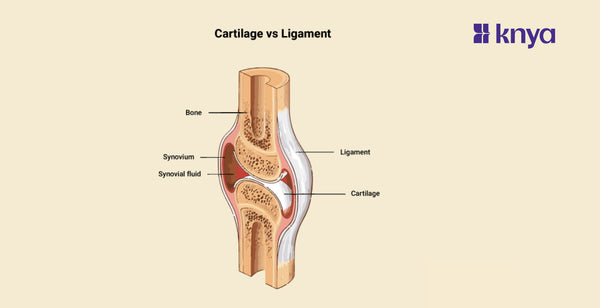Difference Between Cartilage and Ligament: Cartilage and ligaments are both vital connective tissues, yet they have separate roles. Cartilage, a smooth, rubbery pad that rests between bones in joints, acts as a shock absorber and reduces friction, allowing for painless movement. Consider it the cushiony sole of your shoe, shielding your bones from the harsh terrain. Unlike cartilage, ligaments are strong, elastic bands that link bones directly, giving stability and avoiding excessive movement. Consider them the laces on your shoe, keeping everything securely in place. While both are necessary for healthy joints, cartilage loss from accident or ageing can result in painful disorders such as arthritis, whereas ligament rips can cause unexpected instability.
Difference between Cartilage and Ligament
They may not steal the spotlight like muscles or bones, but these silent partners play a crucial part in every step we take, every jump we make, and every breath we breathe. Let’s also understand the differences between Cartilage and Ligament.
|
Feature |
Cartilage |
Ligament |
|
Composition |
Cells (chondrocytes), fibers, ground substance |
Dense, fibrous connective tissue (collagen fibers) |
|
Function |
Support, flexibility, shock absorption |
Connect bone to bone, joint stability |
|
Locations |
Joints, nose, ears, respiratory passages |
Around joints (knee, ankle, elbow) |
|
Types |
Hyaline, elastic, fibrocartilage |
Various types (cruciate, collateral) based on location |
|
Healing |
Limited regenerative capacity, slow healing |
Some self-repair, may require medical intervention |
|
Flexibility |
More flexible than bone, less strong |
Strong, resistant to excessive movement |
|
Connectivity |
Connects bones (e.g., joints) |
Connects bone to bone, reinforces joints |
|
Elasticity |
Elastic cartilage is particularly elastic |
Some elasticity, primarily resists excessive movement |
|
Surface |
Articular cartilage covers joint surfaces |
N/A |
|
Growth |
Involved in growth of long bones (endochondral ossification) |
N/A |
|
Strength |
Less strong compared to ligaments |
Strong, crucial for joint stability |
Browse Best Scrubs Collection
What is Cartilage?
Cartilage is a smooth, elastic connective tissue that cushions and protects the ends of bones in joints. It functions as a shock absorber, keeping bones from rubbing directly against one another and minimising friction during movement. Cartilage also helps to keep joints stable and allows for a greater range of motion. It is present in numerous parts of the body, including the knees, hips, shoulders, elbows, wrists, and ankles.
Key Features of Cartilage:
- Cartilage provides low-friction surfaces at joint ends, allowing bones to glide smoothly against each other. Imagine it like tiny cushions preventing the grinding of bare bones.
- Cartilage works as a shock absorber, softening the force of movement while protecting the underlying bones from stress and injury. Think of it as a trampoline that reduces the jolts to your skeleton.
- Unfortunately, cartilage has an inadequate blood supply and a low regeneration ability. Once injured, it can be difficult to heal, leading to disorders such as osteoarthritis.
- There are several varieties of cartilage, each with a distinct function. Hyaline cartilage lines joint surfaces, fibrocartilage produces discs in the spine, and elastic cartilage protects structures such as the ears and nose.
What is Ligament?
Ligaments are strong, flexible bands of connective tissue that link bones and provide support while limiting excessive movement at joints. Ligaments are made up of collagen fibres that are organised in bundles to provide strength and suppleness. Ligaments vary in size and thickness according to the joint they support. Some of the most significant ligaments in the body include the ACL (anterior cruciate ligament) in the knee, the MCL (medial collateral ligament) in the knee, and the Achilles tendon in the ankle.
Key Features of Ligament:
- Ligaments are tough, fibrous bands that connect bones to bones, providing stability and preventing excessive movement at joints. Imagine them like strong ropes holding bones together.
- Ligaments limit the range of motion in joints, guarding against dislocations and injuries. They ensure joints move within their intended range, preventing unwanted twists and turns.
- Unlike cartilage, ligaments are highly elastic and can stretch to accommodate some movement but still maintain joint stability. Think of them like stretchy bungee cords that keep things in place but allow for controlled movement.
- Compared to cartilage, ligaments have better blood supply and healing potential. While still susceptible to injuries, they can repair and regain function with proper treatment.
Shop Best Lab Coats from Here!
Similarities between Cartilage and Ligament
- Connective Tissue: Both cartilage and ligaments are types of connective tissues in the body.
- Collagen: Both tissues contain collagen fibers, providing strength and structural support.
- Extracellular Matrix: They have an extracellular matrix that contributes to their unique properties and functions.
- Supportive Role: Both cartilage and ligaments play a supportive role in the musculoskeletal system, contributing to joint function and stability.
- Tensile Strength: Both tissues possess tensile strength, resisting forces that may act to pull them apart.
- Involvement in Joints: They are both integral components of joints, with cartilage covering bone surfaces and ligaments connecting bones within the joint.
- Limited Regeneration: Both cartilage and ligaments have limited regenerative capacity compared to some other tissues in the body.
- Critical for Movement: Both tissues are critical for the movement and stability of joints, allowing for coordinated and controlled motion.
Though both necessary for joint function, cartilage and ligaments provide unique functions. Cartilage is a smooth, rubbery cushion that lines the ends of bones, absorbing stress and minimising friction during movement. Ligaments, on the other hand, are strong, rope-like bands that link bones, giving support while restraining excessive joint mobility. Consider cartilage to be a shock absorber, keeping your bones comfy, whereas ligaments serve as gatekeepers, ensuring that your joints do not exceed their limits.
| Check out More Articles | |
| Difference Between Cartilage and Bone | |
| Difference Between Endocrine and Exocrine Glands | |
| Difference Between Cell Wall and Cell Membrane | |















